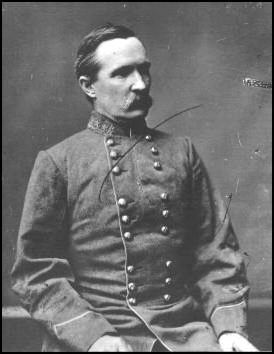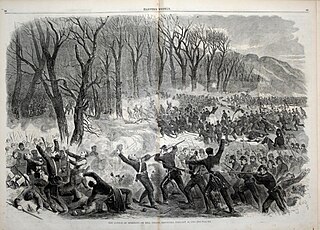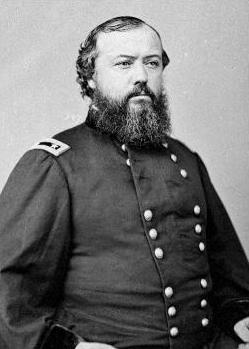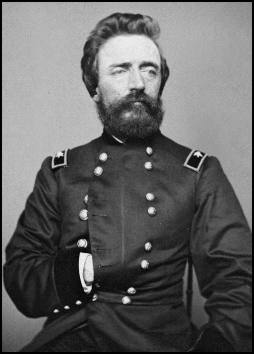
Albert Sidney Johnston was an American military officer who served as a general in three different armies: the Texian Army, the United States Army, and the Confederate States Army. He saw extensive combat during his 34-year military career, fighting actions in the Black Hawk War, the Texas-Indian Wars, the Mexican–American War, the Utah War, and the American Civil War, where he died on the battlefield.

The Battle of Stones River, also known as the Second Battle of Murfreesboro, was fought from December 31, 1862, to January 2, 1863, in Middle Tennessee, as the culmination of the Stones River Campaign in the Western Theater of the American Civil War. Of the major battles of the war, Stones River had the highest percentage of casualties on both sides. The battle ended in Union victory after the Confederate army's withdrawal on January 3, largely due to a series of tactical miscalculations by Confederate Gen. Braxton Bragg, but the victory was costly for the Union army. Nevertheless, it was an important victory for the Union because it provided a much-needed boost in morale after the Union's recent defeat at Fredericksburg and also reinforced President Abraham Lincoln's foundation for issuing the Emancipation Proclamation, which ultimately discouraged European powers from intervening on the Confederacy's behalf.

The Battle of Perryville, also known as the Battle of Chaplin Hills, was fought on October 8, 1862, in the Chaplin Hills west of Perryville, Kentucky, as the culmination of the Confederate Heartland Offensive during the American Civil War. Confederate Gen. Braxton Bragg's Army of Mississippi initially won a tactical victory against primarily a single corps of Maj. Gen. Don Carlos Buell's Union Army of the Ohio. The battle is considered a strategic Union victory, sometimes called the Battle for Kentucky, since Bragg withdrew to Tennessee soon thereafter. The Union retained control of the critical border state of Kentucky for the remainder of the war.

Richard Montgomery Gano was a physician, Protestant minister, and brigadier general in the army of the Confederate States during the American Civil War.

Henry Heth was a career United States Army officer who became a Confederate general in the American Civil War.

The Battle of Mill Springs, also known as the Battle of Fishing Creek in the Confederacy, and the Battle of Logan's Cross Roads or Battle of Somerset in the Union, was fought in Wayne and Pulaski counties, near the current unincorporated community of Nancy, Kentucky, on January 19, 1862, as part of the American Civil War. The Union victory concluded an early Confederate offensive campaign in south central Kentucky.

Charles Champion Gilbert was a United States Army officer during the Mexican–American War and the American Civil War.

Felix Kirk Zollicoffer was an American newspaperman, slave owner, politician, and soldier. A three-term US Representative from Tennessee, an officer in the United States Army, and a Confederate brigadier general during the American Civil War; he led the first Confederate invasion of eastern Kentucky and was killed in action at the Battle of Mill Springs. Zollicoffer was the first Confederate general to die in the Western Theater.

The western theater of the American Civil War encompassed major military operations in the states of Alabama, Georgia, Florida, Mississippi, North Carolina, Kentucky, South Carolina and Tennessee, as well as Louisiana east of the Mississippi River. Operations on the coasts of these states, except for Mobile Bay, are considered part of the Lower Seaboard Theater. Most other operations east of the Appalachian Mountains are part of the eastern theater. Operations west of the Mississippi River took place in the trans-Mississippi theater.
The Orphan Brigade was the nickname of the First Kentucky Brigade, a group of military units recruited from Kentucky to fight for the Confederate States of America during the American Civil War. The brigade was the largest Confederate unit to be recruited from Kentucky during the war. Its original commander was John C. Breckinridge, former United States vice president, and Kentucky's former senator, who was enormously popular with Kentuckians.

Walker's Greyhounds was the popular name for a division of the Confederate States Army under Major-General John George Walker, composed exclusively of units from Texas. It fought in the Western Theater and the Trans-Mississippi Department, gaining its nickname because the men were able to move long distances rapidly on foot.

Hugh Boyle Ewing was a diplomat, author, attorney, and Union Army general during the American Civil War. He was a member of the prestigious Ewing family, son of Thomas Ewing, the eldest brother of Thomas Ewing, Jr. and Charles Ewing, and the foster brother and brother-in-law of William T. Sherman. General Ewing was an ambitious, literate, and erudite officer who held a strong sense of responsibility for the men under his command. He combined his West Point experience with the Civil War system of officer election.
The 79th Regiment Illinois Volunteer Infantry was an infantry regiment that served in the Union Army during the American Civil War.

George Burgwyn Anderson was a Confederate military officer, serving first in the antebellum U.S. Army and then dying from wounds inflicted during the American Civil War while a general officer in the Confederate Army. He was among six generals killed or mortally wounded at the Battle of Antietam in September 1862.
The 22nd Indiana Volunteer Infantry Regiment was an infantry regiment that served in the Union Army during the American Civil War. On October 8, 1862, at the Battle of Perryville, Kentucky, the regiment suffered 65.3% casualties, one of the highest percentages of casualties suffered by any American Civil War regiment in a single engagement.

The 123rd Regiment Illinois Volunteer Infantry, was an infantry and mounted infantry regiment that served in the Union Army during the American Civil War. In 1863 and 1864 it was temporarily known as the 123rd Illinois Volunteer Mounted Infantry Regiment, as part of Wilder's Lightning Brigade.

Walter Chiles Whitaker was an American farmer, attorney, and soldier. He served as an officer in the United States Army during the Mexican–American War, and also was a Union general during the American Civil War. After the war he returned to his profession as an attorney.
The 38th Regiment Indiana Infantry was an infantry regiment that served in the Union Army during the American Civil War.
The Battle of Camp Wildcat was one of the early engagements of the American Civil War. It occurred October 21, 1861, in northern Laurel County, Kentucky during the campaign known as the Kentucky Confederate Offensive or Operations in Eastern Kentucky (1861). The battle is considered one of the first Union victories of the Civil War, and marked the second engagement of troops in the Commonwealth of Kentucky.

The Battle of Augusta was an engagement during the American Civil War that took place on September 27, 1862, in Augusta, Kentucky, between the Bracken County Home Guard (Union) and the Confederate Second Kentucky Cavalry Regiment under command of Colonel Basil W. Duke, a brother-in-law of John H. Morgan. The skirmish resulted in a victory for the Confederacy but the number of Confederate casualties and lack of ammunition for his artillery caused Colonel Duke to abandon plans to cross over the Ohio River into Ohio. A result of the fighting was that twenty buildings were set on fire and destroyed.















